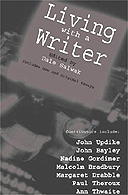
In 1985, I read an interview with John Fowles in which the interviewer put the question: "Elizabeth [Fowles' wife] plays a very important role in your life as wife and critic, doesn't she?"
"A writer's wife is vital. Always, without exception ... " Fowles responded. "I wish someone would study novelists' wives - or husbands."
The comment touched off a whirl of concerns in my mind, spiraling out from my own experiences as a son and husband, scholar and teacher, editor and author. What does it mean to live with a writer? What makes the arrangement work - or not work - and why? How does life at home contribute to the creative process? What is the cost of a masterpiece or a caring relationship? In one way or another, I suspect that there are few writers who haven't at one time or another asked themselves these questions.
Fifteen years passed as other, more pressing, obligations competed for my time and attention. But Fowles' challenge had sparked my interest, and although I filed the idea in a back-burner folder, I didn't forget it. Whenever I came across a related snippet of information - a line in a book review, a passage in a new biography - my original excitement returned.
Finally, in 2000, finding myself in limbo between a completed project and no project, between relief and letdown, the time felt right to begin. Having edited and written a number of books myself by this point, as well as having encountered many authors in my work, I had experienced the creative process from inside and out and was eager to find out from others what they perceived to be the pleasures and problems of living with a writer.
Selecting the book's contributors was a fairly nebulous process - a blend of instinct and coincidence and luck. I began by contacting those writers with whom I was personally acquainted, then extended my field of enquiry to other novelists I had read as well as to prominent poets and biographers. Sometimes one person led me to another, as John Updike did with his son, David. A chance sighting of Judy Carver's address in the TLS resulted in the rare and wonderful opportunity to learn about a daughter's relation to her famous parents, William and Ann Golding. Husbands and wives, other relations and friends - all were encouraged to have a say about the sometimes volatile, sometimes magical chemistry that drives and shapes the creative process.
At first I envisioned having contributions from 25 to 30 seasoned writers, but knowing from experience that some would decline, I wrote to 45. In the event, even the negative responses were revealing. "No matter how I manipulate the calendar," said one, "I just can't seem to squeeze from it the time I would need to turn out an essay. Living with a writer is no cakewalk this year in my household." Another wrote: "I don't want to talk personally. A writer's life is his own affair." Yet another: "My wife certainly wouldn't approve of my writing about her experience of being a writer's wife!" And a fourth: "While I congratulate you on the concept of the book, I think it's one that I should steer away from: it would expose me to just the kind of curiosity I've come to dread."
In the end, however, 27 people did accept my invitation, and for each I provided the book's focus and theme and suggested possible approaches, but left them to decide on a direction for their musings about life with a member of a demanding and sometimes daunting profession. Arrangement in a collection like this one can be a real challenge, but in this instance the 27 pieces fell comfortably into two categories - pleasures or problems - and as the essays arrived the book began to take shape.
Probably because I grew up surrounded by writers and in a home where the work ethic was alive and well, I identified best with those authors who spoke of similar circumstances. "If your father's happy in his work", my mother once told me, "he's likely to be happy in his home." Was she ever resentful of his devotion to work? "I was proud of what he was doing," she said, "and I was just too busy to even give any thought to being resentful. I never felt neglected, never even gave it a thought. To put it simply, I think I worked along with him, but in a different way."
Some friends with whom I have shared this story tell me that my parents were uncommonly lucky. Perhaps so - and yet as I reflect upon the book's stories about Ann and Anthony Thwaite, Margaret Drabble and Michael Holroyd, Malcolm and Elizabeth Bradbury, Julian and Kathleen Symons, and C.P. Snow and Pamela Hansford Johnson, I find resonances to which I connect deeply.
But as many of the essays testify, life with a writer can be troubling, too. "No matter how warm, how engaged as a human being," says Amanda Craig, "there is this necessary detachment that does not sit easily with a happy love-life or a well-balanced family." Essays about Nadine Gordimer, Somerset Maugham, Mary Ann Caws, Peter Levi or Betty Fussell, for example, reminded us of the inevitable tug-of-war between solidarity and solitude that writers face every day in their work. Writing is necessarily an intensely solitary activity, which only another author, perhaps, can fully understand or tolerate, yet writers' loved ones are obliged to accept it as part of the wondrous but also burdensome freight that goes with living with a writer.
· Dale Salwak is professor of English at Citrus College, Glendora, California. Living with a Writer is published by Palgrave Macmillan priced at £18.99.

